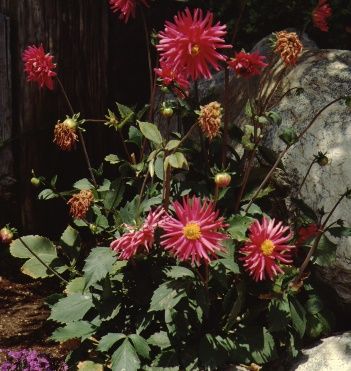Introduction
The many types of dahlia like a fertile, well-drained soil with a constant supply of moisture. Mulch the bed and avoid giving the plants high nitrogen. On poor sites the plants are leggy. Best growth occurs in full sun, but the plants tolerate partial shade. Do not plant dahlias until the soil has warmed up as the roots rot in cold, wet soil. Tall varieties may need a support stake installed at planting time. Removal of side buds gives larger flowers. Remove the old flowers as they fade to promote blooming. Dahlias do not tolerate high summer temperatures so may not be suited for southern most regions.

Credit: Edward F. Gilman, UF/IFAS

Credit: Edward F. Gilman, UF/IFAS
General Information
Scientific name: Dahlia spp.
Pronunciation: DAL-yuh species
Common name(s): dahlia
Family: Asteraceae
Plant type: annual; bulb/tuber; perennial
USDA hardiness zones: all zones (Figure 3)
Planting month for zone 7: May
Planting month for zone 8: May
Planting month for zone 9: Mar; Oct; Nov
Planting month for zone 10 and 11: Sep; Oct; Nov; Dec
Origin: not native to North America
Invasive potential: not known to be invasive
Uses: container or above-ground planter; cut flowers; border
Availability: somewhat available, may have to go out of the region to find the plant

Credit:
Description
Height: 1 to 6 feet
Spread: 1 to 2 feet
Plant habit: oval; upright
Plant density: open
Growth rate: fast
Texture: coarse
Foliage
Leaf arrangement: whorled
Leaf type: simple
Leaf margin: entire
Leaf shape: ovate
Leaf venation: pinnate
Leaf type and persistence: not applicable
Leaf blade length: 4 to 8 inches; 8 to 12 inches
Leaf color: green
Fall color: not applicable
Fall characteristic: not applicable
Flower
Flower color: yellow; white; pink; salmon; lavender; orange; purple
Flower characteristic: showy
Fruit
Fruit shape: no fruit
Fruit length: no fruit
Fruit cover: no fruit
Fruit color: not applicable
Fruit characteristic: inconspicuous and not showy
Trunk and Branches
Trunk/bark/branches: not applicable
Current year stem/twig color: green
Current year stem/twig thickness: very thick
Culture
Light requirement: plant grows in part shade/part sun
Soil tolerances: clay; sand; acidic; loam
Drought tolerance:
Soil salt tolerances: unknown
Plant spacing: 18 to 24 inches
Other
Roots: not applicable
Winter interest: not applicable
Outstanding plant: not particularly outstanding
Pest resistance: long-term health usually not affected by pests
Use and Management
Large varieties are spaced 2½ feetapart, pompoms 2feetapart, and dwarfs 12 to 18inchesapart. Most are planted 6 to 10 inches deep. When shoots are 3 or 4 feet tall, thin them to the three most vigorous shoots. Frosted plants are cut down to 4 to 6 inches above ground level. Dig the roots and allow them to dry. Cover them with sand or peat and store them at 50°F. The roots may be overwintered outdoors in USDA hardiness zones 9 and 10. In USDA hardiness zones 9b, 10, and 11, dahlia is generally planted in the fall for winter and spring color.
Dahlias are propagated by division or cuttings. For cuttings, use new shoots and make cuttings 3 to 4 inches long. Remove the basal leaves and insert the cuttings in sand, perlite, or vermiculite. The root clumps are divided in the spring. Each division needs part of the old stem on it.
Pests and Diseases
Aphids suck plant juices.
European corn borer larvae feed on young leaves and flowers causing them to be distorted and brown. They bore in the stem causing death of plant parts above the bored area.
Stalk borer also bores in the stems.
Leafhoppers cause leaf discoloration along the leaf margins which spreads toward the mid-vein. The affected area is at first yellowish but becomes brown and brittle. If not controlled, the plants are stunted.
Thrips cause the under surfaces of petals to turn white and wither.
Mites cause paling of the leaves.
Crown gall causes large abnormal growths at the base of the infected plant. The plants are stunted and the shoots spindly. Infected plants are destroyed.
Bacterial wilt causes stem drooping and wilting. Infected stems have a wet soft rot near the soil. Destroy infected plants and rotate plantings.
Bacteriosis causes browning and softening of the stem. The pith is moist and blackened with the rot extending into the bark. A foul odor is associated with the disease. The roots may be infected.
Botrytis blight is worse in dull cloudy weather. The buds rot, and infected parts may be covered with grayish powdery mold. Remove infected plant parts.
Powdery mildew causes white or grayish mold. The disease is worse late in the season and badly infected leaves are distorted and drop.
Powdery mildew causes white or grayish mold. The disease is worse late in the season, and badly infected leaves are distorted and drop.
Dahlias growing in heavy, wet soil, and infected with stem rot, wilt and die. A white mold encircles the stem at the soil line. Improve soil drainage and do not crowd the plants. Rotate plantings.
Dahlia mosaic virus causes leaf mottling. Pale green bands develop along the midribs and leaves are dwarfed and show general mosaic or yellow spotting. Destroy infected plants and control the aphids that spread the disease.